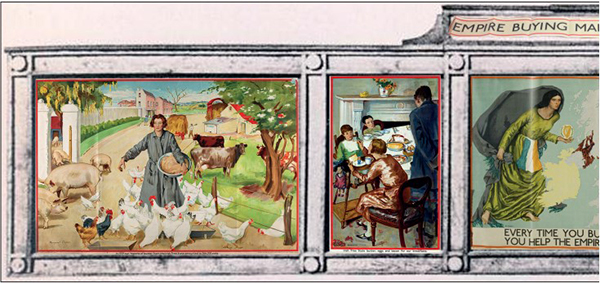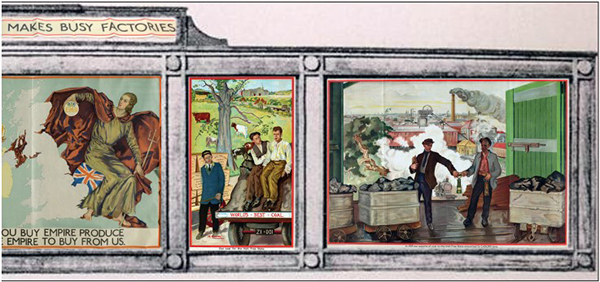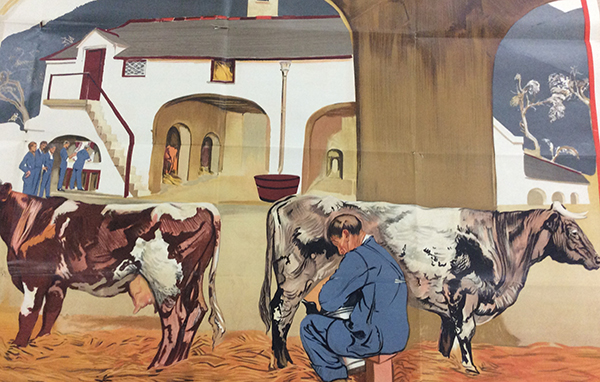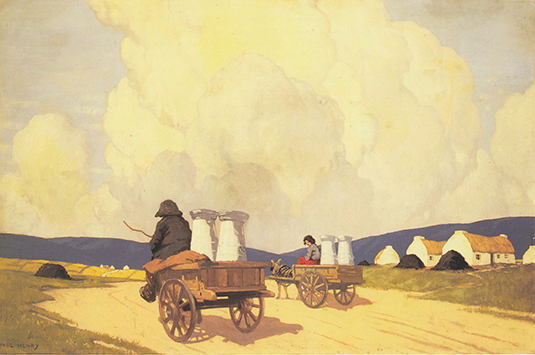Marketing the Free State in Britain
Published in Features, Issue 5 (September/October 2020), Volume 28Irish posters for the Empire Marketing Board (EMB).
By Billy Shortall
In the aftermath of the Irish Civil War and in tough financial times, the Irish economy struggled to the extent that Minister for Finance Ernest Blythe infamously reduced teachers’ salaries and cut a shilling off the old age pension in 1924. Two years later, therefore, when the British government proposed a scheme to increase mutual trade that offered the prospect of increased revenues, the Irish Free State government was eager to take part. Irish Minister for Agriculture Patrick Hogan said that ‘membership of the League of Nations, and all that it implies, may gratify national pride; but what the Free State needs at present is better trade’. He was speaking specifically about improving trade with Britain. Somewhat reminiscent of the current Brexit trade discussions, Britain also wished to negotiate better trade deals. To promote Irish exports, the Irish government and its diplomats in London engaged well-known Irish artists—Paul Henry, Seán Keating, Margaret Clarke and Dorothy Travers-Smith.
The trade initiative was part of a larger scheme to promote trade between Britain and its colonies and dominions, including Ireland. Proposals to increase tariffs on goods from outside the Empire had been abandoned when the public feared higher prices. Instead, the British government established the Empire Marketing Board (EMB) in 1926 to encourage reciprocal trade. Its substantial budget was split between product and export research, and newspaper and poster advertising. Posters were displayed on 1,750 special frames owned by the EMB in 450 towns across the United Kingdom and changed every three or four weeks. In addition, posters were displayed in English factories, advising workers to buy Irish ‘butter, bacon, and eggs’ because ‘orders from the Irish Free State are now in hand at our works’. Buying Irish would result in additional orders.
John W. Dulanty
The EMB hoardings displayed five posters which were almost exclusively designed by English designers and studios. Irish posters advertising Irish produce for British consumers were the exceptions because they were designed by Irish artists. The engagement of Irish artists was the result of the intervention of John W. Dulanty, Irish commissioner for trade in London, who would later become ambassador. Dulanty, an affable and persuasive diplomat, was culturally engaged and friendly with Irish writers and artists, frequently entertaining them in London. He was a member of EMB committees and canvassed for poster design work for Irish artists.
The Free State government sought to effect agency and control over both the production of EMB posters and press advertising where its identity, produce and market were concerned, although the high commissioner at the time, James MacNeill, argued for accepting the publicity as it was, rather than lose ‘the value of an advertisement of this nature in the British press free of expense’.

Above: Margaret Clarke’s set of five posters commissioned by the EMB, as displayed. Designed to be read like a cartoon strip, they showed an Irish farm producing eggs, bacon and butter, followed by an English family eating these at breakfast; the central poster promotes reciprocal trade, the last poster shows an English colliery producing coal, and to its left this coal arrives in Ireland to fuel an Irish creamery while the creamery’s produce goes in the opposite direction. (NLI/UK National Archives, Kew)
Paul Henry and Seán Keating
Five Irish artists were commissioned to produce designs mostly to promote the sale of Irish eggs, bacon and butter. Only three of these had their designs produced as posters; the other two, although approved by the EMB, were censored by the Irish government. The first Irish artist selected was Paul Henry, who by this time had a substantial reputation and whose tourist and railway posters were well known and popular. Henry was commissioned to produce a design for the Irish dairy industry to be exhibited with a poster for English market gardening, which he would also design. However, when Henry’s picture, Dairying in the Irish Free State, was exhibited with other designs at the Royal Academy, London, in November 1926 for visiting premiers, including W.T. Cosgrave, it provoked an extremely negative reaction in the press. Reports regarded it as a tourist advertisement for Irish scenery rather than a promotion of Free State industry and agricultural efficiency. Exhibited beside the New Zealand design for an up-to-date dairy industry, it was seen as backward.
Henry took exception to the public reaction and wrote to the Irish Times, which had reproduced the design, saying that he had verified that donkeys and carts were commonly used to transport milk to dairies. He added that it was perverse to ‘read into my design any suggestion of a reflection upon the agricultural efficiency of the Irish Free State’ and that the complaints demonstrated the Irish inferiority complex. Whatever about its accuracy, Henry’s design was not the image of the Irish agricultural industry that the Irish government wished to portray. The EMB wrote to Henry and told him that they were pulling his design, essentially because the Irish government censored it—‘to respect their wishes’. He declined an offer of 65 guineas to submit a new design, this time to be exhibited in a set with another Irish artist, James Humbert Craig, and his poster promoting the Northern Ireland flax industry. Craig had been selected by the Board on the recommendation of Dulanty and Northern Ireland Minister for Commerce Sir John Milne Barbour. Dulanty purchased the unused original Henry painting.
Seán Keating was approached by Dulanty and commissioned to produce a single poster advertising Irish dairying, but after intervention by the minister for agriculture he was asked to complete a set of three posters. His two later posters, promoting Irish eggs and bacon, were produced at short notice and lack the originality of his dairying image. It represented an ordered and hygienic dairy farm and even if the farmers seem somewhat under-employed it displayed none of Henry’s backwardness. Keating’s posters were exhibited in a five-poster set; the remaining two were letterpress explaining the extent of trade between the Irish Free State and the United Kingdom. Photographs of these posters displayed on public EMB hoardings were sent to Cosgrave, who took both a personal and a political interest in the scheme; he expressed his approval of Keating’s designs.

Margaret Clarke’s five-poster panel
Margaret Clarke designed the only complete set of five posters produced by an Irish artist. She was paid a substantial £275 for the commission. These designs were successful and they won the Publicity Club of London’s prize for the most popular posters to be seen in England in 1931.
Files in the British and Irish national archives and the National Library of Ireland show tensions between the EMB and Irish officials over the maps of Ireland and the UK in the central poster. Dulanty opined that the EMB would want England in red, the Irish Free State would require green and ‘another colour would be needed for the Six Counties’. Other tensions are also evident in the artwork. Press reports mentioned Britannia and Hibernia, who shared this poster, as ‘a symbolic representation of the Irish Free State and Great Britain doing each other a good turn by exchanging their products. Neither of the ladies in this panel, who represent the respective countries, look as if she would give much for nothing.’
Clarke’s first poster shows an Irish farm producing eggs, bacon and butter, while the second shows an English family consuming the produce. Clarke was instructed by the EMB to show how ‘the British housewife should be persuaded into buying the products’. Most of the posters produced by the EMB displayed divided economic and gender roles—men as producers and women as consumers. Clarke’s farm, however, is subversively dominated by a farm woman. Clarke received advice on the Irish farm content from the Department of Agriculture. The EMB had co-opted Frank Pick, Britain’s most prominent marketing expert and a pioneer of commercial art, to its publicity committee; he was responsible for the iconic posters of the London Underground. He requested aesthetic changes to the colliery poster, requiring a landscape element to balance with the Irish farm poster. This resulted in an incongruous tree emerging from the coal fumes. Clarke’s penultimate poster shows the coal arriving in Ireland as Irish farm produce goes the other way. Set in a bucolic and unmistakable Irish landscape, probably the east or midlands rather than the west, the creamery in the distance billows coal, signifying a rural industry, while the manager’s house next door is slated and modern. A coal truck bears an up-to-date Dublin registration and the workers are busy and efficient. It presented a modern vision of Patrick Pearse’s aspiration for rural development.
The poster set was designed to be read like a cartoon strip. It measured approximately 7.6m long by 2m high and had a title strip that read ‘Empire buying makes busy factories’. Explicitly the message to British consumers was that their buying of Irish produce would enable the Irish State to purchase British coal.

Above: Detail of Seán Keating’s poster Irish dairying. Designed for the EMB, it depicted a clean and hygienic Irish dairy farm and avoided the backwardness displayed in the earlier Henry design. (UK National Archives, Kew)
Carlton Studios
One other Irish artist, the set designer Dorothy Travers-Smith (better known after her marriage to playwright Lennox Robinson as Dolly Robinson), was commissioned to produce designs. Although enthusiastically received by Pick and the EMB, her posters, like Henry’s design earlier, were censored by Irish officials and never went into circulation. Dulanty reported to the Board that their message was too indirect and not acceptable. The poster committee doubled her design fee and retained her designs for possible future use. Under pressure at that meeting to agree on another set of Irish poster designs, Dulanty agreed to the commission going to an English design house. The result was a set of three grotesque perfunctory designs created by Carlton Studios, showing a butter box, an egg box and sides of bacon. Maps proposed on these initial designs were eventually replaced with ‘the Irish harp and appropriate animals as depicted on the back of Irish coins’ as a pattern background for each poster and as symbols to convey Irishness. The lack of any Irish location or aesthetic in these designs was also evident in a small number of other Irish-related designs created by English artists.
Posters by Irish artists, and Clarke’s in particular, were as much about portraying a unique Irish identity to the world as they were about promoting trade. The EMB scheme dovetailed with the state’s economic nation-building project, and as part of that the posters communicated an officially approved Irish identity for international consumption, as rural and modern. They looked to a bright future for a new state.

Above: Although a successful poster artist, this Paul Henry design for an EMB poster was rejected because it failed to convey the image of a modernising agricultural industry required by the Irish Free State government.
Economic war
EMB posters were exhibited at various trade shows throughout the UK and occasionally in other Empire countries. The Board proposed showing a number of posters at the 1932 Cork Industrial and Agricultural Fair. This was a major exhibition of Irish food production and industry spread over a thirteen-acre site. Unfortunately it coincided with the outbreak of the ‘economic war’ between Britain and the newly elected de Valera government, which explains why the secretary to the fair refused the EMB permission to display their posters on the grounds that they advertised ‘a number of goods which could be produced in Ireland’. This signalled a change in official policy towards the EMB and trade with the United Kingdom; no further Irish trade posters were commissioned.
The EMB scheme was dissolved after the Ottawa Conference of Empire Nations in 1933. It was a victim of rising nationalism and the introduction of worldwide protectionist tariffs. As the world lurches again towards self-serving nationalism, where will the current Brexit trade negotiations take us?
Billy Shortall is completing a Ph.D in Trinity College, Dublin.
FURTHER READING
M. Cronin, ‘Selling Irish bacon: the Empire Marketing Board and artists of the Free State’, Eire-Ireland 39 (3–4) (2004), 132–43.
M. Horton, Empire Marketing Board posters: Manchester Art Gallery (London, 2010).
U. Kothari, ‘Trade, consumption and development alliances: the historical legacy of the Empire Marketing Board poster campaign’, Third World Quarterly 35 (1) (2014), 43–64.
















